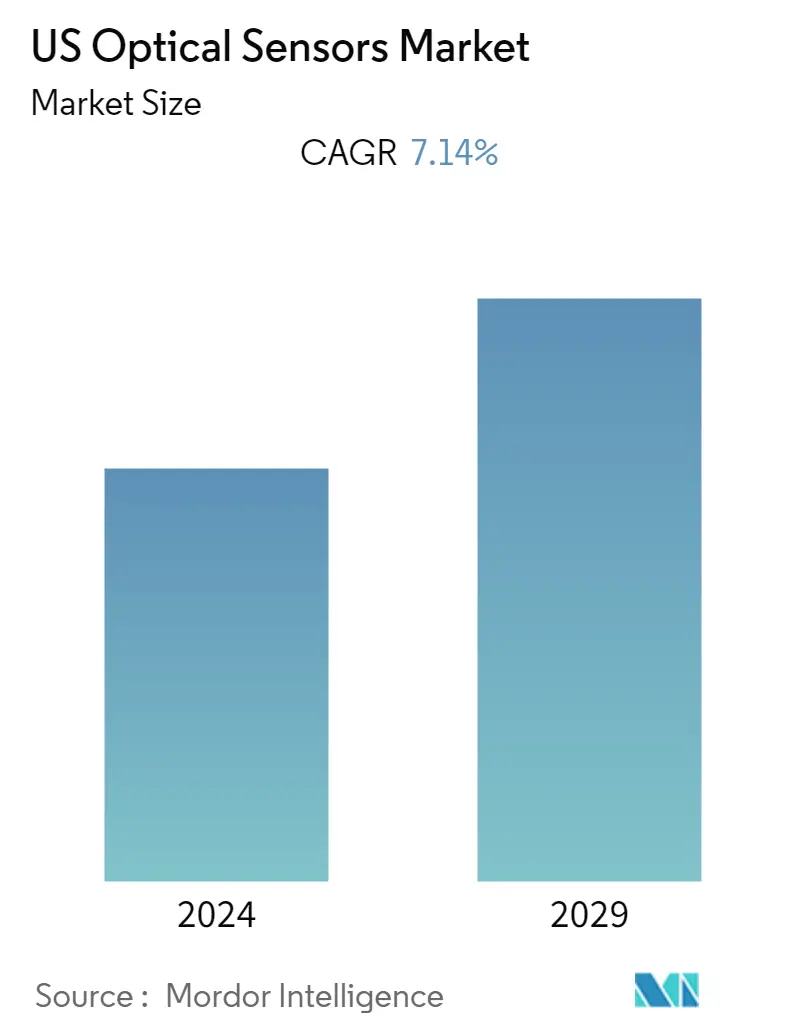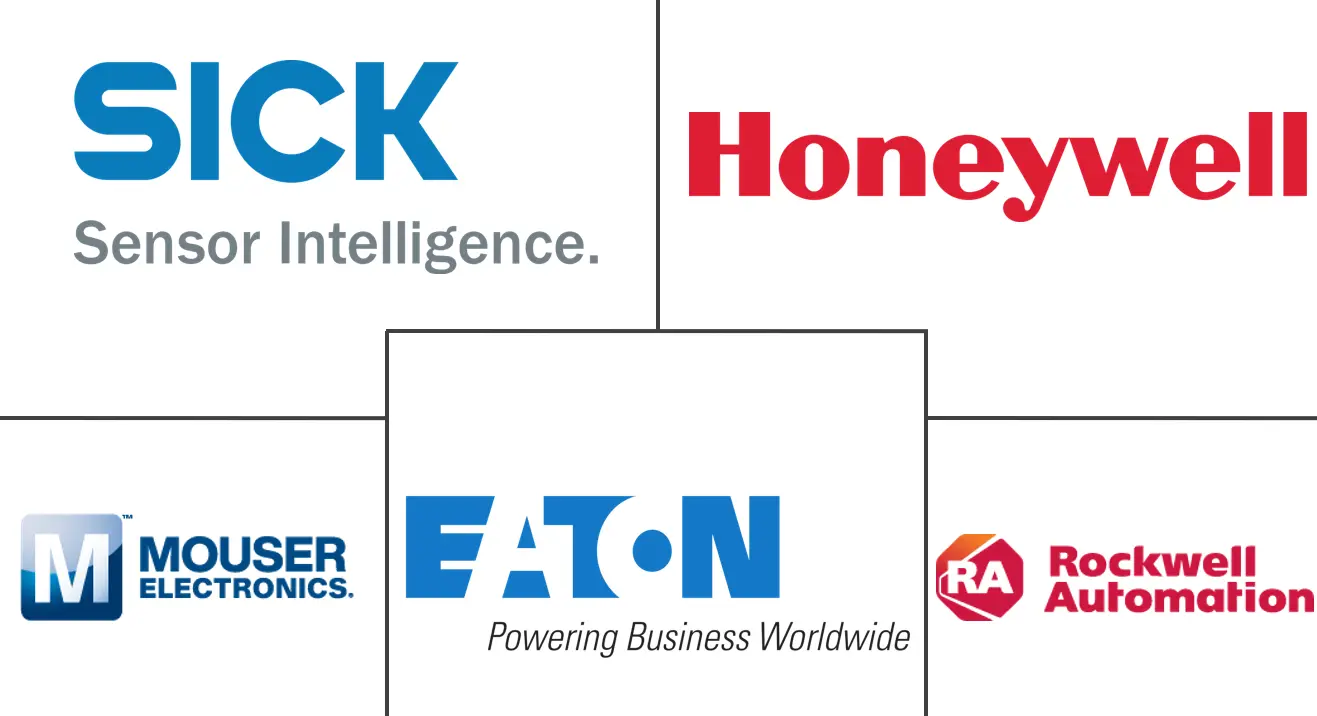
| Study Period | 2019 - 2029 |
| Base Year For Estimation | 2023 |
| Forecast Data Period | 2024 - 2029 |
| Historical Data Period | 2019 - 2022 |
| CAGR | 7.14 % |
| Market Concentration | Low |
Major Players
*Disclaimer: Major Players sorted in no particular order |
US Optical Sensors Market Analysis
The United States has always been one of the biggest markets for consumer electronics, and the growth in the sector has been ever increasing. But the rate has been slower in recent years without high fluctuations. The market is expected to witness a growth of 7.14% in the CAGR over the forecasted period (2021-2026).
According to the Consumer Technology Association (CTA), based on the projected retail sales for 2021, consumer electronics retail sales in the United States reached USD 442 billion. Smartphones were the products accounting for the largest retail revenue within the consumer electronics sector, comprising USD 79 billion in revenue in 2020.
The smartphone household penetration stands at 74% in the United States, which indicates a high potential for household penetration in the country. The United States market is primarily driven by the latest product innovations in the market.
Optical sensors are typically embedded in smartphones, smart wearable, and smartwatches for ambient light and other purposes. Internet of Things (IoT), wearable technology, and health and fitness technology have transformed the United States market and have been primary drivers for increasing the demand for optical sensors.
Smart TVs are also expected to witness high growth in the United States, owing to high multi-functionality. According to comscore, In 2020, Samsung remained the most popular smart TV brand among US households, with a steady share of 32%, followed by Alcatel/TCL and Vizio with 14% and 13% market share, respectively. It is expected that smart TVs will be a part of all households in the United States, which is expected to further increase further, thereby fueling the growth of the market.
Autonomous vehicles, which use optical sensors, have been on the rise in the United States. Companies, such as Waymo, are stationed in the country and have been expanding operations to drive the use of driverless cars. Various states in the country, such as California, have been expanding testing rules to aid the development of driverless cars, which is expected to increase the sales of optical sensors.
US Optical Sensors Industry Segmentation
Optical sensors are used in various commercial and research applications, such as quality and process control, medico technologies, metrology, imaging, and remote sensing. R&D in the field is driven by the expectation that optical sensors will have significant advantages over the conventional sensor types in terms of their properties
Optical sensors are commonly used as sensing elements to process electronic signals. Some of the different types of optical sensors include light sensors, photoelectric sensors, image sensors, infrared detectors, motion sensors, and position sensors.
| Hyperspectral imaging |
| Near IR Spectroscopy |
| Photo-Acoustic Tomography |
| Optical Coherence Tomography |
| Fiber Optic Sensors | |
| Image Sensors | |
| Position Sensors | |
| Ambient light and proximity sensors | Cadmium Sulfide |
| Silicon | |
| InGaAs Sensors | |
| Extended InGaAs Sensors | |
| Infrared Sensors | |
| Other Sensors |
| Commercial | |
| Consumer Electronics | |
| Medical | |
| Automotive | |
| Industrial | |
| Aerospace & Defence | |
| Optocouplers | 4-pin Optocouplers |
| 6-pin Optocouplers | |
| High speed optocouplers | |
| IGBT gate driver optocouplers | |
| Isolation Amplifier Optocouplers | |
| Others |
US Optical Sensors Market Size Summary
The United States optical sensors market is experiencing steady growth, driven by advancements in consumer electronics and the increasing integration of these sensors in various technologies. The market is primarily fueled by innovations in smartphones, smart wearables, and smartwatches, where optical sensors are used for ambient light detection and other functionalities. The rise of the Internet of Things (IoT), wearable technology, and health and fitness tech has significantly boosted the demand for optical sensors. Additionally, the proliferation of smart TVs, with brands like Samsung leading the market, is expected to further propel the market's expansion. The automotive sector also plays a crucial role, with the growing adoption of autonomous vehicles and advanced driver assistance systems (ADAS) necessitating the use of optical sensors for enhanced safety and functionality.
In the industrial sector, optical sensors are increasingly integrated into automated machinery for non-contact detection and measurement applications, supporting the trend towards Industry 4.0. This demand is particularly strong in industries such as packaging, material handling, and automotive, where precision and automation are paramount. The market is characterized by a competitive landscape with established international brands, domestic players, and new entrants vying for market share. Strategic mergers, acquisitions, and investments in research and development are common as companies seek to expand their market presence. Recent innovations, such as the CMOS Global Shutter Sensor by ams AG and the Optical Caliper Measurement Sensor by Honeywell, highlight the ongoing technological advancements driving the market forward.
US Optical Sensors Market Size - Table of Contents
1. MARKET DYNAMICS
-
1.1 Market Drivers
- 1.1.1 Increasing Market Penetration of Smartphones
- 1.1.2 Increasing Demand for Power-saving Devices Across Industries
- 1.1.3 Increasing Market Penetration of Automation Techniques Across Various Industries
-
1.2 Market Restraints
- 1.2.1 Imbalance Between the Image Quality and Price
2. MARKET SEGMENTATION
-
2.1 Technology
- 2.1.1 Hyperspectral imaging
- 2.1.2 Near IR Spectroscopy
- 2.1.3 Photo-Acoustic Tomography
- 2.1.4 Optical Coherence Tomography
-
2.2 Sensor Type
- 2.2.1 Fiber Optic Sensors
- 2.2.2 Image Sensors
- 2.2.3 Position Sensors
- 2.2.4 Ambient light and proximity sensors
- 2.2.4.1 Cadmium Sulfide
- 2.2.4.2 Silicon
- 2.2.4.3 InGaAs Sensors
- 2.2.4.4 Extended InGaAs Sensors
- 2.2.5 Infrared Sensors
- 2.2.6 Other Sensors
-
2.3 Applications
- 2.3.1 Commercial
- 2.3.2 Consumer Electronics
- 2.3.3 Medical
- 2.3.4 Automotive
- 2.3.5 Industrial
- 2.3.6 Aerospace & Defence
- 2.3.7 Optocouplers
- 2.3.7.1 4-pin Optocouplers
- 2.3.7.2 6-pin Optocouplers
- 2.3.7.3 High speed optocouplers
- 2.3.7.4 IGBT gate driver optocouplers
- 2.3.7.5 Isolation Amplifier Optocouplers
- 2.3.8 Others
US Optical Sensors Market Research FAQs
What is the current US Optical Sensors Market size?
The US Optical Sensors Market is projected to register a CAGR of 7.14% during the forecast period (2025-2030)
Who are the key players in US Optical Sensors Market?
Mouser Electronics Inc., Sick AG, Rockwell Automation, Honeywell Inc. and Eaton Corporation are the major companies operating in the US Optical Sensors Market.


